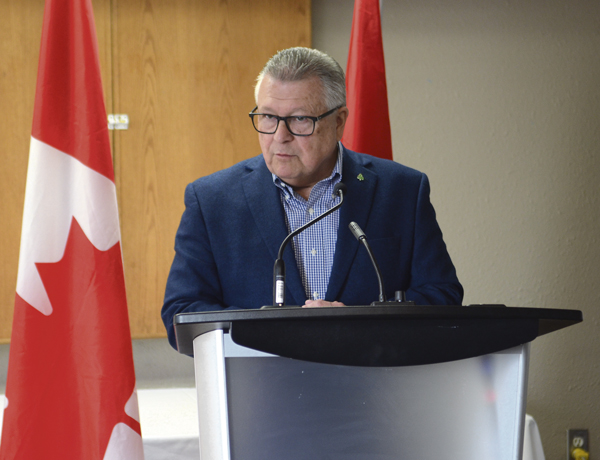Three northern Saskatchewan communities will be getting a boost from the federal government as they work to reduce crime and gang activity by directing and mentoring young people toward safe and more healthy life choices.
Ile A La Crosse, Pelican Lake First nation and Witchekan Lake First Nation each received $400,000 to help strengthen their capacity to cope more effectively with youth crime.
The announcements were three of six made by Public Safety Minister Ralph Goodale during a visit to Prince Albert Tuesday. The communities had applied under a nation-wide competition held to find local solutions to issues facing youth.
“They will identify their most pressing needs, assess how well or not those needs are currently being met, identify the gaps that need to be bridged and muster the local leadership and resources to become more effective at keeping kids safe and healthy,” Goodale said.
“The scope is flexible, aimed at what will be the most effective in the local circumstances. We want to provide strong, positive healthy alternatives to stop the downward spiral of youth crime and violence.”
In Pelican Lake, the community will be using the resources to help intervene before kids get caught up in the gang lifestyle.
“It’s not so much about the money as it is what we’re going to be able to do,” said band manager Jim Ramsay.
“What this will allow us to do is to take a real positive and proactive approach, so instead of always reacting to tragedy, we’ll be able to intervene. Man, we’re going to be able to stop a lot of our young adults from going down the path of no return.”
Ramsay said the community is trying to do more before it comes time to call the police or serve a criminal sentence. Some of that work is being done in the justice system, where young people who have gotten into trouble are being directed back to school and into the skilled trades or other training, saving them from criminal records.
The First nation will be directing the $400,000 to hire staff to intervene and help young people every day.
‘We’ll be using the contribution in a number of ways. One way is to try to reach our youth who sometimes may be tempted into the gang thinking and those types of relationships. We’ll have that direct intervention in our schools, which is really important,” Ramsay said.
‘We’ll be able to have a liaison with corrections and the RCMP, so we’ll have more of a community policing presence. Instead of going in when there’s a problem and somebody has got to be arrested and all this intervention, we’ll be able to do a lot more prevention.”
Other initiatives in the various communities funded under Tuesday’s announcement include operating and some repair costs for a youth centre and a land-based education program.
Unlike other programs, which sometimes come with a dictated plan attached, this funding envelope was left more open on purpose.
“There’s not a rigid preset formula that says ‘you shall do this,’” Goodale said.
“Communities are in the best position to identify what will work with their young people. That’s the whole point to be flexible and allow the local leadership, empower the local leadership to lead the way towards the solutions that will be the most effective.”
That approach was praised by Ramsay.
“It’s like Canada is saying to Pelican Lake First Nation, ‘We’re going to give you resources, we definitely need to work with you, but we’re going to work with you in a way where you guys are the leaders,’” he said.
“’You know what’s best in your communities. You know what works best with your families, what works best in schools.’ This is more of a cooperative recognition that solutions come from the community. Solutions do not come from bureaucrats.”
The projects being undertaken will also be observed and assessed, both to find how effective they can be and to see if some of it can be replicated in other communities.
Multiple times Tuesday, Goodale said he’d be paying attention to the projects and “watching closely” to see what they can accomplish.
Ramsay also saw this as a positive.
“One of the tragedies of the past is, so often, even with good intentions, large amounts of money would be flowed into communities by bureaucrats with programs. They set all the rules and the money is gone, but nobody bothered to find out if the outcomes are better,” he said.
“Here, we’re talking about the opportunity to measure results: ‘what was effective? What works? Honestly, what didn’t work and why?’ When you can prove what’s effective, then you can replicate it in other communities.”


